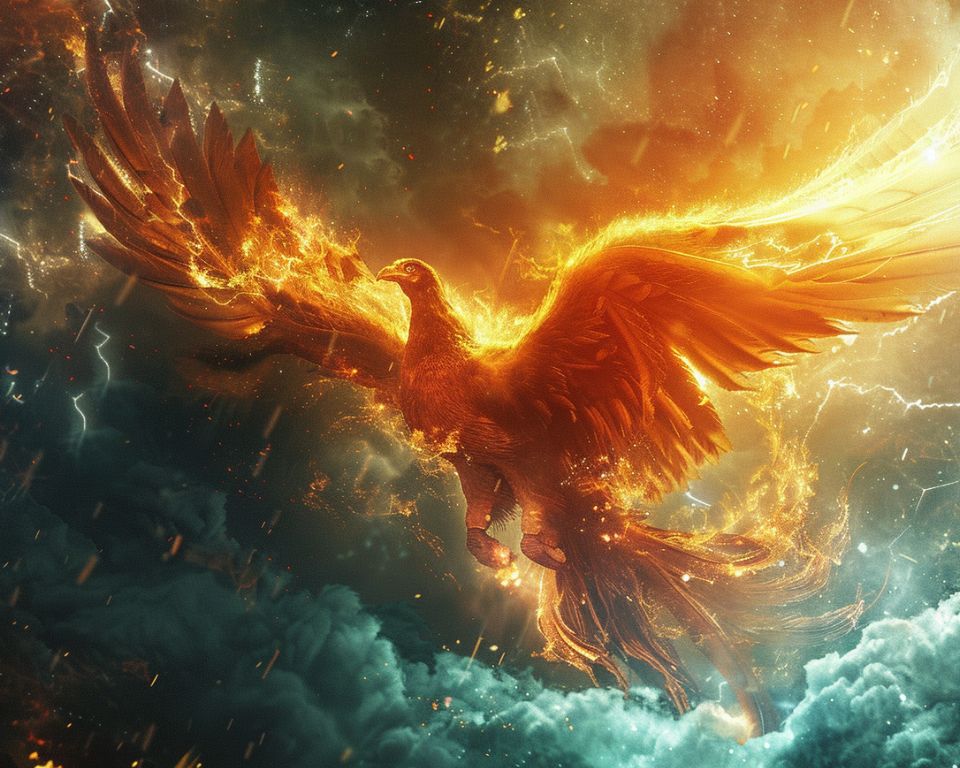Imagine a bird so beautiful and so magical that it never truly dies.
This incredible creature is the Phoenix, a legendary bird from Greek mythology that is as mesmerizing as it is powerful.
In this article, we’re going to uncover the rich tapestry of meanings and stories behind the Phoenix.
We’ll explore its symbolism of rebirth and immortality, take a closer look at how this mythological bird weaves through Greek myths, and see how it compares to similar mythical birds from other cultures.
Not stopping at the ancient times, we’ll also delve into how the Phoenix has stayed relevant, finding its place in modern literature and popular culture.
From its fiery rebirth to its association with the sun, the Phoenix offers a captivating glimpse into how ancient Greeks viewed the world and the life cycle.
Key Takeaways
- The Phoenix is a powerful symbol of rebirth and immortality in Greek mythology.
- It is associated with the sun and fire, emphasizing its role in themes of renewal and purification.
- The Phoenix’s story reflects ancient Greek beliefs about death, rebirth, and the eternal cycle of life.
- Similar mythical birds in different cultures highlight the universal appeal of the Phoenix’s symbolism.
- In modern times, the Phoenix continues to inspire literature, movies, and popular culture, representing hope, strength, and renewal.
The Symbolism of the Phoenix
We often find ourselves fascinated by the idea of immortality and renewal, themes deeply embedded in the tale of the Phoenix.
This mythical bird, revered in Greek mythology, is believed to live for hundreds, if not thousands, of years before it dies by bursting into flames.
Yet, from the ashes of its predecessor, a new Phoenix arises, symbolizing the cycle of death and rebirth. This powerful imagery has cemented the Phoenix as a symbol of rebirth and immortality, reflecting the human desire for life to continue everlastingly.
Its connection to the sun, often depicted with a radiance that rivals the morning light, emphasizes its role as a life-giver and a bringer of renewal.
Through this symbolism, the Phoenix encourages us to embrace change and the possibility of new beginnings.
The Phoenix in Greek Myths
In Greek mythology, the story of the Phoenix is not just a tale of rebirth and beauty; it’s a story that intertwines with the very fabric of Greek religious and cultural beliefs.
The Phoenix’s life cycle—burning into flames and being reborn from the ashes—serves as a potent symbol for the ancient Greeks’ understanding of life, death, and the possibility of renewal.
Unlike other mythological creatures, the Phoenix stands alone in its association with fire and rebirth, making it unique among Greek myths.
This solitude in its mythology underscores the Phoenix’s significance as a creature beyond compare, embodying eternal life and the endless cycle of the cosmos.
Through the Phoenix, the Greeks expressed their insights into the mysteries of life and the universe, offering hope and a reminder of the enduring spirit of nature and humanity.
Comparative Mythology
The tale of the Phoenix is not unique to Greek mythology alone; it shares similarities with mythical birds from various cultures around the world.
For instance, the Fenghuang in Chinese mythology and the Firebird in Slavic tales both embody themes of renewal, rebirth, and immortality, much like the Phoenix.
These cross-cultural parallels highlight the universal appeal of the Phoenix’s symbolism—the desire for life to triumph over death, and for renewal to follow destruction.
Across these different cultures, the Phoenix and its counterparts stand as powerful symbols of hope, resilience, and the unending cycle of life.
This universal symbolism of renewal, transcending geographical and cultural boundaries, underscores the shared human experience and our collective longing for continuity, rebirth, and transformation.
Modern Interpretations
The Phoenix continues to capture our imagination, resonating with themes of hope, strength, and renewal in contemporary literature, movies, and popular culture.
Its symbolism has seamlessly woven itself into the fabric of modern storytelling, embodying the human spirit’s resilience and the potential for rebirth amidst adversity.
In literature, the Phoenix often represents characters or situations that undergo significant transformation, emerging stronger and wiser from their trials.
Movies and television shows utilize the Phoenix motif to illustrate themes of survival, rebirth, and the power of second chances.
Furthermore, in everyday language, the term “Phoenix” has come to symbolize an entity or person that rises from defeat or despair, stronger and more vibrant than before.
This enduring appeal of the Phoenix, from ancient myths to modern narratives, underscores our continuous fascination with the idea of overcoming the impossible and finding renewal in the face of challenges.
Conclusion
In our journey through the myths, symbols, and lasting legacy of the Phoenix, we’ve traversed ancient beliefs and modern interpretations, witnessing the timeless appeal of this mythical creature.
The Phoenix’s story, spanning cultures and epochs, remains a powerful testament to humanity’s enduring fascination with rebirth, renewal, and the cyclical nature of existence.
As a symbol, the Phoenix encourages us to embrace change, confront challenges with resilience, and hold onto the hope of new beginnings, no matter the circumstances.
Its immortal flame, reborn from the ashes, inspires us to believe in the possibility of transformation and the enduring strength of the human spirit.
As we conclude, we’re reminded that the essence of the Phoenix is not just found in the pages of mythology books or the scenes of movies but in our ability to rise, time and again, from the ashes of our trials and tribulations, forever reborn, forever renewed.
Frequently Asked Questions
1. How long does a Phoenix live before it is reborn?
The life span of a Phoenix varies in the stories, but it is often described as living for hundreds or even thousands of years. At the end of its life cycle, it builds a nest of aromatic branches and spices, sets it on fire, and is consumed in the flames. From the ashes, a new Phoenix arises, reborn and ready to live again.
2. Does the Phoenix have any special powers?
Besides its ability to be reborn from its ashes, the Phoenix is often attributed with great strength, the ability to heal with its tears, and a melodious song that can bring joy or even enchant the listener. Its power also lies in its symbolism of rebirth, immortality, and resilience.
3. Are there any temples or cults dedicated to the Phoenix in ancient Greece?
There is no solid evidence of temples or specific cults dedicated solely to the worship of the Phoenix in ancient Greece. The Phoenix primarily serves as a powerful symbol within mythology, representing themes of renewal and immortality rather than being an object of direct worship like the gods and goddesses in the Greek pantheon.
4. How has the symbolism of the Phoenix evolved in modern times?
In modern times, the Phoenix has become a universal symbol of overcoming adversity and emerging stronger from challenges. It is often used to represent personal growth, transformation, and the triumph of the human spirit over difficulties. This symbolism is evident in literature, movies, and popular culture, where the Phoenix is depicted as a source of inspiration and hope for renewal and new beginnings.


